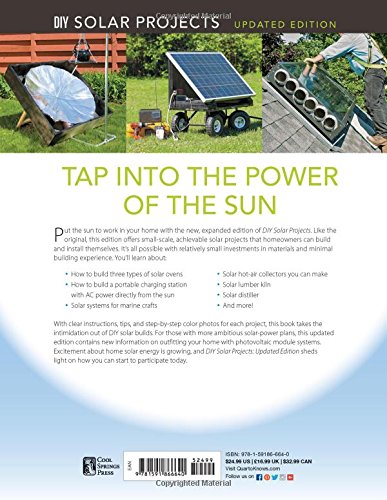Description
Price: $11.99
(as of Oct 22,2023 05:35:03 UTC – Details)
From the Publisher
More Watts Equals More Work








Once powered by a windmill that needed frequent maintenance, this deep well, which pumps water to a nearby stock tank, is now powered directly by solar modules. Instead of pumping on demand, the motor pumps water continuously when the sun is out and stores it in a large tank.
Water for irrigation is continuously pumped from a deep aquifer up to this storage tank during the day as long as the sun is shining.
A solar-powered roof vent fan draws hot air from the attic during the day when the sun is out—the time when the attic is hottest. This type of fan generally does not include a battery, and is powered directly by the solar module (although some manufacturers offer models with backup wind or AC power).
A multimeter is a good diagnostic tool for checking a photovoltaic module to ensure it is working properly. It also allows you to check the power generated at different angles and locations.


Mounting Solar Modules
Mounting an array of solar modules so everything stays in place for decades can be the most demanding part of a solar installation. With so much surface area the modules can catch gusts of wind almost as well as a sail. An array also must hold up against rain, snow loads, hail, and whatever else nature dishes out. This requires secure mounting to a roof, the ground, or the side of a house or other structure, using rust-resistant metal poles or racking and the best stainless-steel hardware.
The large surface area of solar panels means that they must be very securely mounted to resist the force of the wind.
How to Install a 12-Volt Solar Light System






Step 1
Locate the roof rafters, either by using a stud finder or by lifting up shingle tabs and tapping in finish nails. You must plan to fasten at least one of the angled mounting brackets to a rafter. If the other doesn’t fall on a rafter, plan to attach it with toggle bolt anchors
Step 2
Predrill the holes for the mounting brackets (above), then fill them with roofing cement or silicone caulk (left). Fasten the brackets to the roof with neoprene screws (small lag screws with a rubber washer), or with toggle bolts if not attaching to a rafter.
Step 3
Fit the bottom of the first collector module neatly into the slot in the mounting frame assembly.


Solar Ovens
Solar ovens and cookers are simple devices that capture heat from the sun with a reflective surface that’s angled or curved toward a cooking pot. Because they can be made easily from cheap materials such as scrap cardboard and tinfoil, they are widely used in areas of the world where trees and fossil fuel are scarce or expensive. Once made, they can be used to cook food and boil water in a reasonable amount of time for absolutely no cost.


How to Build a Roof or Ground Support for a Solar Collector
You can make a sturdy support for either PV panels or solar collectors by assembling lengths of Unistrut U-channel (sold at home centers and electrical suppliers; see Resources, page 186) and then anchoring them to the roof or ground. Use galvanized or stainless-steel pieces and fasteners, and follow the same guidelines for selecting a location and height.
Publisher : Cool Springs Press; Illustrated edition (January 1, 2017)
Language : English
Paperback : 192 pages
ISBN-10 : 1591866642
ISBN-13 : 978-1591866640
Item Weight : 1.6 pounds
Dimensions : 8.25 x 0.75 x 10.65 inches







